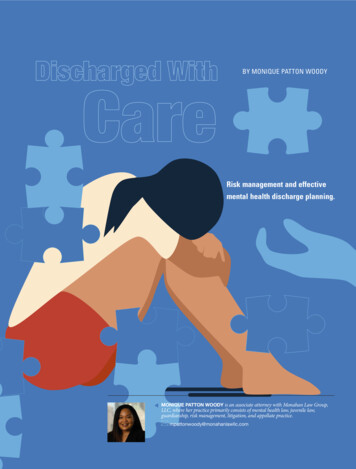
Transcription
Discharged WithCareBY MONIQUE PATTON WOODYRisk management and effectivemental health discharge planning. MONIQUE PATTON WOODY is an associate attorney with Monahan Law Group,LLC, where her practice primarily consists of mental health law, juvenile law,guardianship, risk management, litigation, and appellate practice.mpattonwoody@monahanlawllc.com
TAKEAWAYS What may matter most is whether themental health treatment center and healthcare providers exercised reasonable careregarding discharge planning even if theirdecisions led to negative consequences. Any high-quality discharge plan mustaddress ongoing treatment, medicationmanagement, and monitoring. Nopostdischarge placement should take placewithout a plan that ensures the patient willcontinue with treatment.FAR TOO OFTEN, MY COLLEAGUESAND I FIELD CALLS AND INQUIRIESFROM hospitals regarding patients withmental illness and in need of dischargeplacement for various reasons, includinghomelessness, inability to live independently,or a need for transitional programming beforereturning to independent living. However, inthese matters, placement is but one piece ofthe puzzle. Discharge planning for patientswith mental illness also requires a carefulsafety assessment and evaluation of medicationcompliance and community and familysupports. When sufficient attention is not paidto each of these components, any discharge issimply the beginning of another admission foryet another mental health crisis.Many patients with mental illness areclosely acquainted with the “revolving door”approach to mental health assistance. Toillustrate, a patient will present to a hospitalemergency room for a mental health crisis, isadmitted for any number of days, dischargedwith a prescription that no one ever ensuresis filled or taken, and directed to a shelter thatprovides few resources other than a bed anda roof. A short time later, sometimes days,that same patient returns to the emergencyroom for another mental health crisis. It Hospital attorneys should advisetheir clients to consider implementinga discharge model such as the POSTapproach, which covers various aspects ofa patient’s placement, outpatient services,support system, and treatment plan.can be a never-ending cycle. Even in caseswhere involuntary-commitment petitions arefiled in mental health court,1 if the hospitaland treatment team elect to discharge thepatient rather than proceed to an involuntarycommitment hearing, the commitmentpetition is withdrawn and the court’sinvolvement ceases unless and until the patientis involuntarily admitted again.2By failing to engage in proper dischargeplanning, including following appropriate andprofessional intervention to achieve stability,a hospital can easily subject itself to potentialliability if the discharged patient experiencingmental illness causes harm to themselves orsomeone else. Effective mental health dischargeplanning requires far more than handingthe patient a couple of discharge papers anda prescription. Hospitals and mental healthfacilities have a “duty to exercise reasonablecare to protect [patients] against foreseeableinjury.”3 In determining whether hospitals1. 405 ILCS 5/3-601.2. See id. at § 5/3-604 (petitions for involuntarycommitment only serve to permit the hospital to keepthe patient in the hospital against their will pendinga commitment hearing pursuant to Article VIII of theMental Health Code; hospitals and their physicians canand do sometimes determine that a patient no longermeets involuntary commitment criteria after the filing of acommitment petition).3. Williams v. State, 65 Ill. Ct. Cl. 106, 109 (2013).ISBA RESOURCES Joseph T. Monahan, Three-Legged Stool of Mental Health Treatment, MentalHealth Matters (Nov. 2021), law.isba.org/3OzMYWx. Susan Dawson-Tibbits, Powers of Attorney: Pitfalls and Best Practices Part 2—Powersof Attorney for Health Care, Trusts & Estates (June 2020), law.isba.org/3yhoXyu. ISBA Free On-Demand CLE, Brush up on Mental Health Law (recorded May 2020), law.isba.org/3NjQcwy.2
BY FAILING TO ENGAGE IN PROPERDISCHARGE PLANNING, INCLUDINGFOLLOWING APPROPRIATE ANDPROFESSIONAL INTERVENTION TOACHIEVE STABILITY, A HOSPITALCAN EASILY SUBJECT ITSELFTO POTENTIAL LIABILITY IF THEDISCHARGED PATIENT EXPERIENCINGMENTAL ILLNESS CAUSES HARM TOTHEMSELVES OR SOMEONE ELSE.and mental health facilities have metthis standard, courts consider “whethermedical personnel made reasonabledecisions at the time of examination andtreatment.”4 The key is whether reasonablecare was exercised by the hospital andmedical professionals in rendering theirultimate judgment, not merely whetherthe judgment ultimately proved to bewrong.5Caselaw and lawsuitsThere is no shortage of casesdemonstrating that a failure to dedicatethe necessary time and resources todevelop and implement an appropriatedischarge plan can prove to be morecostly—in both time and financialresources—than hospitals or mentalhealth facilities anticipate, even if thefacility is successful in the end. In 1999, anIllinois hospital was ordered to pay 6.5million in damages after the hospital failedto properly evaluate a patient and deniedher admission for treatment; she latercommitted suicide.6 In Novak v. Rathnam,a father sued the psychiatrist andpsychologist who approved the dischargeof a patient from a mental health facility;the patient then traveled to Florida wherehe shot and killed the plaintiff ’s daughter.7In Jinkins v. Lee, a patient fatally shothimself in the head after being dischargedfrom a state mental health facility, and thedecedent’s administrator sued two medicalprofessionals for wrongful death claimingthey failed to properly diagnose and treather late husband’s mental illness, whichincluded a significant history of multiplesuicide attempts and homicidal ideation.8In recent years, hospitals have beenrequired to respond to lawsuits filed againstthem for alleged negligent dischargeplanning. In October 2020, a widow fileda lawsuit against a hospital in MadisonCounty alleging that the hospital failed toproperly evaluate and admit her husbandwho presented to the hospital experiencinghallucinations, paranoia, and suicidalideations; the hospital prescribed thehusband some medication and dischargedhim. He allegedly committed suicide thatnight by hanging himself.9 In late 2021, theattorneys for a 24-year-old college studentannounced the filing of a lawsuit against aNew Lenox hospital for what they allegedwas a “negligent discharge.”10 Accordingto the lawsuit, the student presented to thehospital due to experiencing symptomsconsistent with psychiatric illness. Variousnews outlets reported that the hospitaldid not admit him and instead dischargedhim, at which point local police officerstransported the student to a parking lotand instructed him to walk alongside abusy street.11 The student wandered intotraffic, was struck by a vehicle, and sufferedpermanent brain damage.Hospitals, mental health facilities, andpractitioners will not always accuratelyforecast every issue that may arisepostdischarge. The key is that hospitalsand practitioners should engage in athorough analysis of the potential risksof discharge and implement plans thatminimize the risk of postdischargeliability. Attorneys offering riskmanagement advice to their hospitaland practitioner clients would do well toensure that all mental health dischargeplanning is thorough and effectively aimedtoward achieving long-term stability.This not only decreases the likelihood ofanother mental health crisis requiringhospital intervention in the short term,but also potentially insulates the hospitalfrom liability for negligence in failing to3create an appropriate discharge plan.Discharge planningDischarge planning has been definedby the U.S. Substance Abuse andMental Health Services Administration(SAMHSA) as “the process to preparea person for return or reentry to thecommunity, and the linkage of theindividual to essential communitytreatment, housing and human services.”12From the moment a patient presents toa mental health facility, the treatmentteam (including physicians, psychiatrists,psychologists, social workers, therapists,family members, and attorneys) shouldbe conducting clinical assessments ofthat patient’s needs, capacity, insight intohis or her illness, potential treatmentplans, and aftercare services neededupon discharge. Mental health treatmentplanning does not lend itself well to a onesize-fits-all approach. In all cases, the bestpossible outcomes for patients dependon treatment professionals who have theresolve and forethought to begin craftingclinically appropriate discharge plansthat address the patient’s specific levels ofneed, ability to adhere to a treatment plan,severity of illness, and other related needsto ensure long-term stability.4. Id. at 109.5. Id.6. Janan Hanna, Hospital Gets 6.5 Million Tabin Suicide, Chicago Tribune (Jul. 28, 1999), law.isba.org/3HNdmtW.7. Novak v. Rathnam, 106 Ill. 2d 478 (1985) (casewas on appeal as both defendants refused to testifyciting the Confidentiality Act; and was later dismissedbased in part on claims barred by res judicata, and inpart, because the discharge occurred approximatelyone year prior to killing).8. Jinkins v. Lee, 209 Ill. 2d 320, 321-26 (2004).9. See Complaint in Woodside v. Rahul Bansal,M.D. and Granite City Illinois Hosp. Co., LLC d/b/aGateway Reg’l Med. Ctr, No. 2020L 001435 (Cir. Ct.Madison County); Marian Johns, Psychiatrist SuedOver Patient’s Suicide Following Hospital Discharge,Madison–St. Clair Record (Oct. 26, 2020), law.isba.org/3bsk2rn.10. Clifford Law Offices, UIC Transfer StudentFrom Jordan Sues Silver Cross Hospital & New LenoxPolice Dept. (Nov. 3, 2021), law.isba.org/3boStch.11. See, e.g., Stacey Baca, Jordanian Student’sMother Suing New Lenox Police, Silver Cross HospitalAfter Brain Injury, ABC 7 (Nov. 3, 2021), law.isba.org/3ydKY0S; TJ Kremer III, Lawsuit Blames SilverCross, Police for Man’s Injuries: Report, Patch (Nov. 4,2021), law.isba.org/3OA0n0N.12. See U.S. Department of Health & HumanServices, Evaluability Assessment of DischargePlanning and the Prevention of Homelessness (Sept.21, 2005), law.isba.org/3nar0Ef.
Attorneys providing risk-managementadvice to hospitals and mental healthfacilities should advise that the first stepin any discharge plan is to conduct a riskassessment that evaluates the patient’scapacity for self-care and likelihoodof self-harm or harm to others inthe immediate postdischarge period.This assessment must be more than adetermination that the patient has notmade a suicidal or homicidal ideationor physical threat within the past 24hours; medical professionals should alsoclosely analyze subtle signs of unresolvedmental health issues, as many mentalhealth patients can credibly presenttemporary stability just to be releasedfrom the hospital. Information on thepatient’s history of treatment compliance,behavioral patterns, and availability ofoutside supports can all be of value here.This critical first step sets the tone for theevaluator in determining what kind ofcommunity interventions will be needed.Information for this assessment can begathered from mental health and socialwork professionals who have workedwith the patient during their stay. If thereis a release of information, you mayalso gather information from mentalhealth and social work professionalswho are familiar with the patient. Familymembers and friends can also prove tobe an abundant source of informationas they often have the most intimate andlongstanding experience with the patient.Family members andconfidentialityPrior to January 2022, under theIllinois Mental Health and DevelopmentalDisabilities Confidentiality Act, allcommunications regarding a mentalhealth patient are confidential, includingthe fact of the patient’s admission intothe hospital.13 Thus, unless the patientauthorizes disclosure or an exceptionapplies, hospitals and professionals areprohibited from sharing information withfamily members regardless of the level of afamily member’s involvement prior to thepatient’s hospitalization. Given the then-mental state of the patient, it is exceedinglyrare for a patient with unresolved mentalillness to grant authorization for disclosure.Typically, there are no applicable exceptionspermitting hospitals to speak with familymembers regarding the patient’s care.Effective Jan. 1, 2022, Senate Bill 1970 (SB1970) seeks to resolve this issue. Under SB1970, the Confidentiality Act was amendedto permit hospitals to provide qualifyingfamily members with limited informationregarding discharge planning details.To qualify, the family member must:1) provide proof of identity to thehospital; 2) provide a written statementattesting that there are no pendingorder-of-protection or domesticrelations matters; and 3) demonstratesignificant involvement in meeting thepatient’s health care needs.14 Significantinvolvement can be demonstrated byevidence that the patient and familymember reside at the same address orthat the family member assists in fillingpsychotropic medications and can providethe name of the prescribing provider;regularly assists in attending mental healthappointments; holds the health insurancepolicy that covers the recipient’s mentalhealth care; or is an adult parent, spouse,sibling, or grandchild of the patient.15Additionally, the treatment teammust determine that the patient lackscapacity to make a reasoned decisionregarding disclosure, the patient is notat risk of abuse or neglect as a result ofthe disclosure, and that disclosure is inthe best interest of the patient.16 With thebenefit of an exchange of informationfrom a family member, hospitals are thenable to obtain a full and reliable pictureof the recipient’s severity, patterns, andmental health history.The POST modelFollowing a risk assessment, attorneysshould instruct their mental health professional clients to conduct a needs assessment based upon the determinations madeduring the patient’s stay, history, and riskassessment. A helpful tool for covering apatient’s full needs upon discharge is POST:4DISCHARGE PLANNING HAS BEENDEFINED BY THE U.S. SUBSTANCEABUSE AND MENTAL HEALTHSERVICES ADMINISTRATION(SAMHSA) AS “THE PROCESS TOPREPARE A PERSON FOR RETURN ORREENTRY TO THE COMMUNITY, ANDTHE LINKAGE OF THE INDIVIDUAL TOESSENTIAL COMMUNITY TREATMENT,HOUSING AND HUMAN SERVICES.”placement, outpatient services, supportsystem, and treatment. POST stands forthe four critical areas of discharge planningthat can work to ensure long-term stabilityfor individuals with mental illness.Placement. Some patients will havethe capacity and ability to live in theirown apartment or community settingeither individually or with family. Otherpatients will have a greater level of needand will need to reside either in a group ornursing home or more structured setting.In any case, every discharge should beto a placement that is safe, clinicallyappropriate, and conducive to treatmentplan adherence.Outpatient services. Most, if not all,patients will require continued outpatientservices upon discharge depending upontheir own unique circumstances. Somepatients may be experiencing substanceaddiction or medical problems exacerbatedby their mental illness. So, outpatientservices can include individual, group,or some other form of therapy, drug andalcohol treatment, or related medicalservice treatment. Individuals living withmental illness often lack the capacity toobtain mental health treatment, let alonetend to a host of other comorbid issuesand conditions. An effective discharge plan13. 740 ILCS 110/2; id. at § 110/3.14. Pub. Act 102-0372 (eff. Jan. 1, 2022) (adding740 ILCS 110/5.5).15. Id.16. Id.
will implement the necessary communityresources and minimize barriers to gettingcoordinated and integrated care outside ofthe hospital setting.Support system. Family members andfriends are not just a source of informationfor medical and mental health providers,they are key components to an individual’slong-term success in treatment-planadherence. From helping with managingmedications to providing transportationto appointments to providing emotionalsupport, a patient’s support system is vitalto that patient’s success. Mental healthand social work professionals should,to the extent practicable, include familymembers and friends in the dischargeplanning process—especially given thechanging legal landscape permittinghospitals to speak with family. This groupis equipped to provide unique insights ontreatments and resources that could have amarked impact on the patient’s outcomes.Treatment. Probably the most important component of any discharge planis the ongoing treatment, medicationmanagement, and monitoring. Hospitalsand mental health facilities often identify a postdischarge placement withoutconsidering a plan for ensuring that thepatient will continue to adhere to a treatment plan. This crucial step should notbe overlooked. Once a patient becomesdestabilized due to a lack of adherence totreatment, not only do patient and careprofessionals risk returning to squareone, but in some cases, it also can becomeincreasingly difficult to find new medication regimens that effectively manage apatient’s mental health symptoms. Thisresults in more frequent, increasinglycostly, and lengthier hospital stays—thevery opposite of what all parties intended.Holding patients accountableYou may be thinking “Sure, thissounds great. But we can’t make anyonedo anything once they are not in thehospital.” To address this conundrum,hospital attorneys can look to the AssistedOutpatient Treatment (AOT) order. AnAOT is a court order that outlines theparameters of the patient’s dischargeplan and is entered near the time ofdischarge.17 The AOT integrates the termsof the patient’s discharge plan into theinitial order and is in effect for up to 180days (with the potential to be extended,if necessary).18 An AOT’s enforceabilitymechanism lies in its ability to requirethe patient to comply with the order/treatment plan or be placed back into thehospital for treatment.19 Thus, the AOTis a tool that can be used to hold patientsaccountable and incentivize adherenceto the treatment plan. The idea is that,after adherence to the treatment plan forthe duration of the AOT, the patient canbecome sufficiently stabilized that he/sheis likely to continue to improve.Few things in life are truly permanentand managing mental illness can be ajourney of peaks and valleys. Attorneysfor hospitals and treatment centers shouldadvise their clients to become investedin crafting multidimensional dischargeplans that consider the recipient’s need formedication compliance and monitoring,necessary postdischarge communitysupports, and dedicated family memberswho can assist in maintaining stabilitywith the appropriate clinical supports.Comprehensive and effective dischargeplanning is not only beneficial for patients,it can also: benefit hospital clients byslowing the revolving door of high-acuitypatients who frequently utilize hospitalemergency rooms for mental health crises;decrease litigation associated with thefiling of commitment petitions; and lessenthe risk of liability for wrongful deathor negligent discharge should a patientcause harm to himself or someone elsepostdischarge.While it can require some logisticalacrobatics to put the necessary resourcesin place, all hospitals and mental healthfacilities should strive for “goodbye” andnot “see you later.”17. 405 ILCS 5/3-801.5.18. Id. at § 5/3-801.5(g); id. at § 5/3-813(b).19. Id. at § 5/3-801.5(b).Reprinted with permission of the Illinois Bar Journal, Vol. 110 #8, August 2022.Copyright by the Illinois State Bar Association. isba.org5
MONIQUE PATTON WOODY is an associate attorney with Monahan Law Group, LLC, where her practice primarily consists of mental health law, juvenile law, guardianship, risk management, litigation, and appellate practice. . one year prior to killing). 8. Jinkins v. Lee, 209 Ill. 2d 320, 321-26 (2004). 9. See Complaint in . Woodside v. Rahul Bansal .










